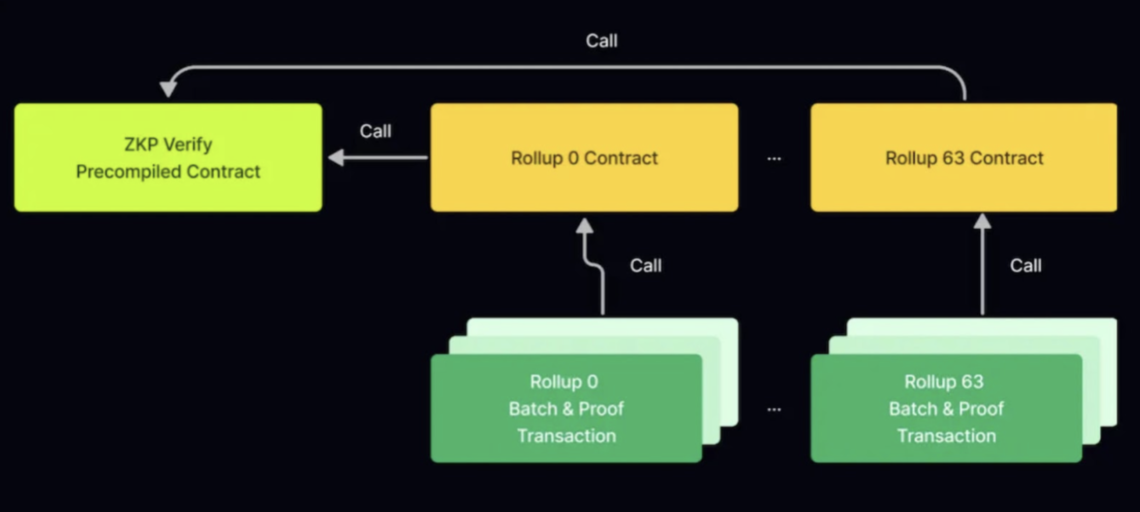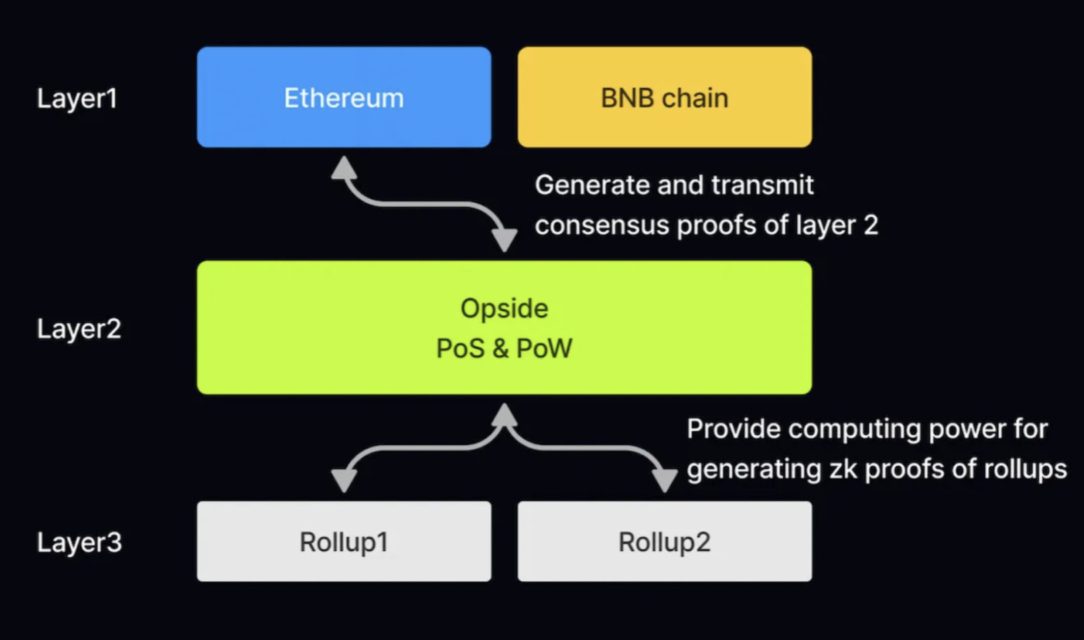Opsideis a decentralized ZK-Rollup-as-a-Service (built on the modular blockchain concept). ZK-RaaS) network.
OpsideBy developing a sophisticated three-layer blockchain architecture, Proof-of-Stake ( PoS) and Proof-of-Work ( PoW ) combines the strengths of consensus mechanisms. This innovative design Web3A robust and feature-rich software that can be effortlessly created with one click to its developers. zkEVMpresents the chain.
In the scalability area, Tier 2 ( L2 ) concept is widely accepted. With this, L2limitations, data availability, zero-knowledge proof ( ZKP) computing capabilities and peer-to-peer ( P2P ) is due to its inability to effectively integrate various hardware resources, including nodes. This has led to the emergence of the modular blockchain concept.
Things to Know About Opside
Opside’s innovative three-tier architecture seamlessly combines various modules and provides Zero Information Collection as an external Service ( ZK-RaaS) by offering the platform L2built on the foundation.
L1, Public Chain: Among examples Ethereum, BNB ChainAnd polygontakes place.
L2, Opside Chain: Opsidecomprehensive decentralized consensus, data availability, and zero-knowledge proof ( ZKP ) provides computational capabilities. All transactions and data generated on the chain, Layer 2 ( L2 ) is subject to verification and storage on As a result, transactions are processed quickly and fees are minimal.
L3, Aggregation Layer : Rollups increase scalability by off-chain resource-intensive computations. Opside, at first polygon Hermez, scroll, Taiko, zkSyncand more zkEVMA wide variety of Zero-Knowledge-Rounding Software Development Kits (including SDKs ) offers. Decentralized Opsidenetwork provides all the necessary hardware resources, while the developers themselves ZK-Rollupprojects to Layer 3 of Opside ( L3) can be placed effortlessly.
The various layers are connected to each other via different cross-chain bridges so that the assets can be removed from Layer 1 ( L1) to Layer 2 ( L2) or Layer 3 ( L3) ensures a smooth transfer.
ZK-RaaS
ZK-RaaS (ZK-Rollup as a Service) refers to providing one-click production service for ZK-Rollups.
Opside, developers ZK-Rollupstheir projects Opside L3a general tool that they can use to easily deploy ZK-Rollups SDK it provides. Opside L3‘Fame ZK-Rollup ‘s are governed by a system agreement, including registration, suspension and cancellation. To get a ZK-Rollup, developers need a certain amount of IDE ( Opside token) with a rollup You can rent a home. This concept polkadot‘gift of jewelry parachainsimilar to their nests, but Opside L2And L3It shares the same consensus and data availability layer, resulting in higher security, more decentralized maintenance costs and lower costs.

Developers renting a collection slot zkEVMThey get an independent execution environment, similar to having a chain. ZK-Rollup They have full control over it and allow customization of the economic model, including gas token selection. Developers have the flexibility to adjust the gas fee or even reduce it to zero, ensuring that users are not charged any fees. Also, Layer 3 ( L3) on various ZK-RollupCross rollup communication between projects is possible.
Developers do not need to incur any hardware costs. Data availability, sequencer, and zero-knowledge proof ( ZKP) all core hardware resources such as computing power, Proof-of-Stake ( PoS) and Proof-of-Work ( PoW) is provided by the decentralized hybrid consensus of mechanisms.
PoS & PoW Hybrid Consensus
ZK-Rollup, OP-Rollup It has several advantages over ., such as improved security, no trust requirements and faster withdrawals. An important technical difference is ZK-Rollup requires strong ZKP computing power to support zero-knowledge proof generation. In the future, the Opside network will ZKPhundreds or thousands that make up the Aggregation Layer, which will create a significant demand for computation ZK-Rollup can occur from. To address this, it is crucial to encourage miners to participate and contribute to the ecosystem. From Ethereum’s Proof-of-Work ( PoW) to Proof-of-Stake ( PoS) with the passage of approximately 12 billion dollarsA large number of Ethereum miners representing a market capitalization have become obsolete.
ZK-RollupAs technology matures, ZKP production requires substantial hardware and mining equipment such as FPGAs and GPUs. Opside’s PoSAnd PoWhash consensus is used only to motivate validators to provide data availability. PoSmechanism, but also miners ZKPto encourage computing power PoWuses.

This approach provides a comprehensive hardware solution for ZK-Rollup and represents one of Opside’s core ideas. All participants, including users, developers, node operators and miners, can benefit from the Opside economic model.
Opside, ZK-Rollup It aims to allow . to inherit not only the security of previous layers, but also a degree of decentralization. Currently the largest decentralized network in the world, Ethereum has over 500,000 nodes and provides tremendous decentralization. Thanks to data storage technology, these nodes will also offer significant data availability in the future. This is one reason why Opside chose to develop the PoS consensus based on ETH 2.0. Opside envisions hosting over 100,000 nodes. In order to achieve a similar level of decentralization for Rollup, it is a viable strategy for Opside Chain’s block recommender to propose blocks for the Rollup Layer. This approach separates generators and recommenders for the Aggregation Layer: generators are supported by an unlicensed P2P network, and recommenders follow the Layer 2 block recommender. This eliminates the availability risks associated with a single node and adds Miner Extractable Value ( MEV) and offers resistance to censorship.
Hybrid PoS & PoW reconciliation requires the following division of labor:
Layer 2 (L2):
PoS: Opside will adopt and enhance the PoS of ETH 2.0, resulting in a consensus layer with 100,000+ validators. Anyone can stake IDE tokens to become validators. Additionally, Opside’s PoS is provable, and validators periodically send proof of PoS to Tier 1. Validators can earn block rewards and gas fees at Tier 2.
Layer 3 (L3):
PoS ( sorter ): The validator recommends not only layer 2 blocks, but also layer 3 blocks (i.e. data stack); i.e. validators are also sorters of local aggregations at layer 3. Sequencers can earn gas fees from the transaction on tier 3 transactions.
PoW ( Confirmatory ): Anyone can be a proof of local roundup as long as they have enough computational power for the ZKP calculation. Validators generate ZK proofs for each local aggregation in layer 3. A proofer generates ZK proof for each block of tier 3 served by the sequencer according to PoW rules.
A ZK-Rollup is similar to a computer with two basic components: a hard disk and a CPU. The data availability provided by PoS is similar to the hard drive while the computing power offered by PoW is similar to the CPU. Opside aims to strike a balance between PoS and PoW by enabling each role to fully realize its value and benefit while providing enhanced performance and user experience for the large-scale ZK-Rollups network. Achieving this balance will ensure that the Opside network can efficiently support the large ZKP computing demand generated by a large number of ZK-Rollups.
Opside can effectively leverage the strengths of both PoS and PoW mechanisms to create a robust and sustainable ecosystem that meets the needs of all its participants, including users, developers, node operators and miners. As Opside continues to grow and evolve, ZK-Rollup will play an important role in promoting the adoption of technology and developing a decentralized, scalable and secure environment for blockchain applications. This comprehensive approach will contribute to the long-term success and widespread use of ZK-Rollups in the blockchain environment.
Token Supply and Demand
IDE ( Opside tokenThe allocation details for ) are as follows: Maximum 10 billion IDEs will be printed. 10 percent is reserved for venture funding, 14 percent is reserved for the Opside team and contributors, and 15 percent is reserved for the community, which includes early testers, ecosystem project developers, and potential future airdrops. 28 percent is dedicated to the foundation to support ecosystem development, follow-up financing and other causes. The remaining 33 percent is used as rewards for validators and miners who provide data storage services, generate zero-knowledge proofs, protect blockchains and execute contracts. The token distribution table is as follows:

In accordance with hybrid PoS and PoW consensus, the block reward is divided into two parts allocated to validators and miners respectively. During the Pre-Alpha testnet phase, the temporary block reward ratio for PoS and PoW is fixed at 1:2, meaning 11 percent of the IDE is assigned to validators, while 22 percent is set for miners. In the future, this rate will be adjusted dynamically according to the demand and supply of ZKP computing power across the entire network.
Reward of PoS
As mentioned earlier, Opside uses a PoS consensus based on an enhanced version of ETH 2.0.
To participate as a validator, users must deposit a certain amount of IDE into the deposit agreement and run three separate pieces of software: execution client, consensus client, and validator. Validators are responsible for verifying the validity of new blocks propagated over the network and creating and propagating new blocks themselves from time to time. If a validator acts dishonestly or negligently, the staked IDE will be forfeited.
Under PoS, OpsideIt has a fixed block generation rate and has time slots ( 12 seconds) and epochs ( 32 time slots ) is split. In each slot, a randomly selected validator acts as the block recommender, responsible for generating new blocks and sending them to other nodes in the network. Also, in each slot, a random committee of validators is chosen to determine the validity of the proposed block using their votes. For full mechanism please ETH PoSsee .
Opside, Alphain the testnet EIP-4844Data Availability Sampling ( DAS ) plans to use. Validators randomly sample transaction data from the blob to verify that all data is available. This technique can also enable block producers to make all their data available to secure light clients. Under the Bidder-Builder Separation (PBS), only the block generator needs to consider the entire block, while other validators use data availability sampling for validation.
Opside will differ in some specific parameters that readers can find in the codebase.
Overall, staking simplifies participation in network protection and encourages decentralization. Validation nodes can be run on standard laptops, and some proxy staking pools even allow users to stake without sufficient IDE balance.
PoW’s Awards
In Opside’s L3 or Aggregation Layer, each Web3 application has a custom ZK-Rollup may have . To support the extensive hardware resources required by multiple ZK-Rollups Opside, This ZK-Rollup It provides a unified ZKP computing marketplace as well as validators that offer data availability to create ZKPs for . This creates Opside’s PoW mechanism.
Prize share calculation for a single roundup string
In the Pre-Alpha phase, only one sequence can be sent per Rollup in an L2 block (which may include multiple blocks of this Rollup). All sequences equally share the current block’s PoW reward based on the number of registered Gathering slots. This means that if there are currently 64 registered Gathering slots, each array in an L2 block will receive 1/64th of the PoW reward. Some rollups may not send sequences in some blocks, resulting in lower true PoW inflation.
In the future, individual arrays will be priced differently based on workload estimates, taking into account factors such as ZK-Rollup type, throughput, and gas usage.
I Two-stage ZKP delivery
The PoW reward share obtained by a series is allocated according to certain rules to the senders of valid ZKPs, i.e. miners. When Rollup’s smart contract validates ZKPs, it needs original proof data, which can trigger on-chain attacks. For example, after a particular proofer calculates the ZKP, the transaction is broadcast to the transaction pool and the attacker can see the raw proof data and the attacker can set a higher gas fee for sending the transaction, thus prioritizing packing into the block to receive the PoW reward. To prevent malicious attacks, Opside proposes a two-stage submission mechanism for ZKP verification.

1) Submit the hash
For a given string, after the proof has calculated the ZKP, it calculates the (proof/address) hash and sends the hash and address to the contract; where the proof is the proof of a particular sequence and the address is the address of the proofreader who has to bet beforehand
Assuming that the first proofer sends hashes in the T block, hashes from the other proofers are accepted up to the T+10 block, with no number limit. No new validator will be accepted for hashing on and after the T+11 block.
2) Submit the ZKP
After the T+11 block, any authenticator is allowed to send ZKP as long as a ZKP passes verification, then all submitted hashes are validated. Any prover who passes the verification receives a PoW reward, which is distributed proportionally to the amount deposited by the miner.
If no ZKP passes validation by block T+20, 1,000 IDEs sent by all the hashes are lost, at which point the queue is reopened to allow new hashes to be sent.
For example, suppose the PoW reward for each L2 block in the Opside chain is 128 IDEs and there are 64 Aggregation slots in total, then the PoW reward allocated to each Aggregation thread is 2 IDEs. So the PoW reward for A, B and C is 0.4 IDE, 1 IDE and 0.6 IDE respectively.
Prover Piling and Cutting
To avoid malicious behavior towards Prover, the prover must sign up to a special system contract and stake at least 100,000 IDEs. If the current stake is less than the threshold, hash and ZKP submission will not be allowed. Prover’s reward for sending ZKP will also be distributed proportionally to the stake, thus preventing malicious behavior of the prover sending ZKP multiple times. Different levels of penalties will apply when Prover:
If the proofer sends the wrong hash, the penalty will be 10,000 IDEs.
For a string, if no corresponding ZKP is validated, all IDEs that send a hash will be truncated by 1,000.
Cut IDEs will be burned.
Readers are referred to the official documentation for more details and considerations about ZKP’s two-step application mechanism. The exact number of prover commitments and penalties may change in the future.
Rollup slot rental for developers
Opside offers a ZK-Rollup launch platform for developers, allowing them to register a Rollup slot with one click to create their own ZK-Rollup. Opside’s decentralized network provides all the necessary hardware resources for ZK-Rollup. Developers only need to pay a certain rent to the Opside network for the Rollup slot, which is then burned.
In addition to a fixed rental amount, developers can provide additional ZKP subsidies for their ZK-Rollups to encourage miners to provide computing power. This feature will be introduced on Alpha Testnet.
Readers can find specific rent and subsidy rules and parameters in official documentation or in the code base. These measures contribute to the continued growth and optimization of the Opside network, promoting a thriving ZK-Rollup-as-a-Service ecosystem.
Governance and Development
The functionality and performance of the Opside network will evolve over time with a few high priority examples outlined below:
Dynamic scaling of PoW reward allocation with PoS based on ZKP computing supply and demand across the network
Increasing data storage capacity for the entire Rollup Tier through data slicing and data availability sampling of validators, thereby adapting to the wider ZK-Rollup ecosystem
Separating the rollup’s recommender and generator allows Layer 3 to share Layer 2’s validator as the block recommender and inherit the decentralization of the previous layer.
Optimizing the staking and slashing mechanism for miners to promote the provision of consistent and stable ZKP computing power
Developers subsidize ZKP production for their own Rollups to encourage miners to provide computational power
Establishing a personalized pricing mechanism for Rollup batches based on workload estimation, taking into account factors such as ZK-Rollup type, transaction volume and gas usage.
These enhancements will significantly increase Opside’s network utilization and support the long-term development and prosperity of ZK-Rollup as a Service.
Following the launch of the Opside mainnet, an Opside DAO (Decentralized Autonomous Organization) will be established with rational processes and mechanisms to collectively determine the future of the network. All updates to the parameters and mechanisms of the Opside mainnet will be decided through the Opside DAO. It is important to emphasize that Opside represents an economy that has evolved over time and is built collaboratively. Future improvements will be in the form of DAO recommendations detailing how these solutions will benefit the long-term interests of the Opside economy and each category of participants. As the network expands, it is crucial to build an economy that can function independently and robustly without extensive tools and subsidies.







